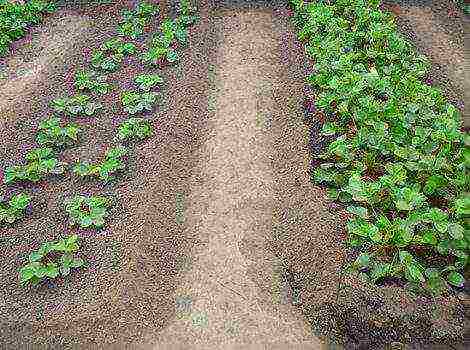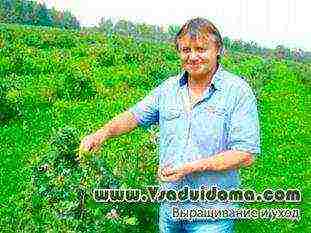Content
- 1 Who is Galina Kizima
- 2 Life experiences and strawberries
- 3 What to do in 5 years?
- 4 Where to get seedlings
- 5 What strawberries love
- 6 What to do with foliage
- 7 Opinion about disease
- 8 About pests
- 9 conclusions
- 10 Video about the principles of growing crops according to the method of Galina Kizima
- 11 Galina Kizima's method
- 12 Technique for growing seedlings in diapers
- 13 The main principles of the technique
- 14 Methods to reduce the labor intensity of gardening
- 15 Features of growing potatoes
- 16 Subtleties of cultivation of strawberries
Each person has his own opinion about the agricultural technology of a particular culture, which is based on knowledge and experience. So Galina Kizima decided to share her vision of cultivating tasty and aromatic berries with the world.
Who is Galina Kizima
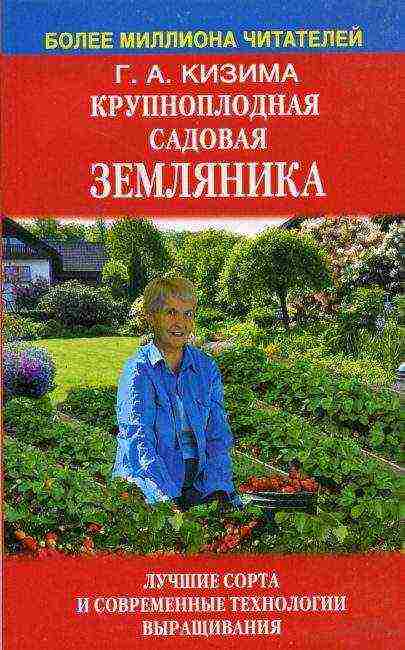
Galina Kizima is the author of many popular books, one of which tells about the peculiarities of growing garden strawberries.
Being a non-professional (with the education of a physicist), she had a hobby all her life - garden beds on 6 acres. Being an inquisitive person, I never got tired of studying and testing knowledge on my estate. For half a century, she gained a lot of knowledge and experience, and she decided to "lay out" them in the form of manuals for vegetable growers and amateur gardeners.
What is valuable about experience?
Galina Kizima does not pretend that vegetable growers and gardeners unconditionally adopt her experience, she simply describes it and constantly encourages people to experiment in order to have their own opinion.
Perhaps it will seem strange to someone that a physicist is not writing about physics. There is more than enough literature in the world on agricultural technology for the cultivation of horticultural and vegetable crops written by agronomists and agrochemists, but experience is a great thing, and it is impossible not to use it.
Having a mathematical mindset, Galina Kizima approaches all garden affairs with accurate mathematical calculations and inspiration, which is not available to everyone.
Life experiences and strawberries
Kizima urges strawberries to be called by their botanical name - large-fruited strawberries, since this is correct. The word "strawberry" has become so common that, probably, hardly anyone will listen to the opinion of Galina Dmitrievna.
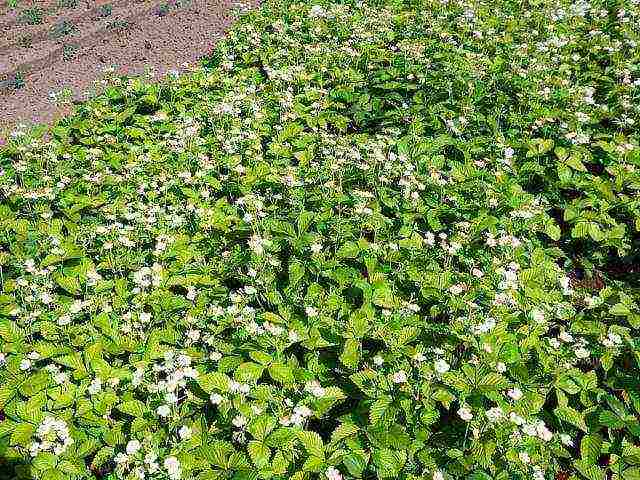
Galina is sure that strawberries in the garden should grow as freely as in nature.
Observing nature, Kizima wonders why the gardener puts so much work into the formation of even beds. The call to leave strawberries alone, to give them the opportunity to form a carpet on their own, is based on the entire technology of planting and caring for this crop.
In defense of this method, the "writer" puts forward the following arguments:
- no need for weeding;
- the mustache is not cut;
- foliage is not removed.
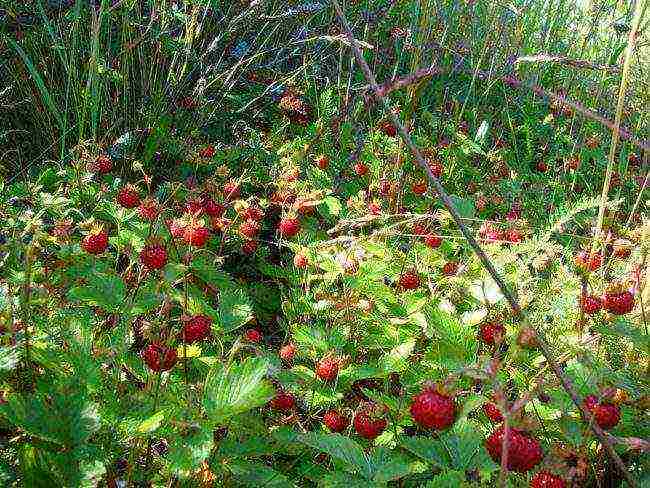
Wildly grown strawberries gradually fill the space around them.
The need for watering
However, it should be watered, and in order not to feed it, the author recommends adding 10 g of AVA fertilizer per square meter to the soil before planting, and this, as she believes, will be enough for 3 years.
However, if you do not make it, then 1 tbsp should be scattered directly over the foliage. l / m2 azofoski, or dissolve this fertilizer in a bucket of water and water.
Over time, the mustache gives out sockets and there is no free space. Then the strawberries begin to look for new areas and so that this does not arise, it should be limited by digging around the perimeter or installing boards.

Trying this method of growing strawberries in your area, it is better to immediately limit the growth of the plantation.
What to do in 5 years?
Strawberries bear fruit quite steadily for 3-4 years.Further, its yield decreases, the bushes age, and the beds need to be removed.
In this case, Kizima recommends a rather original method.
- After harvesting, the beds are covered with weeds, straw, foliage, waste, that is, they turn into a compost heap. To make the decomposition processes take place faster, it is recommended to pour everything with preparations such as "Baikal", "Renaissance"... Then everything is covered with a black film and left until the next season.
- With the arrival of spring, the film is removed, and the entire area is abundantly treated several times per season with a working solution of a preparation based on microorganisms "Fitosporin"In the company with the drug"Gumi».
- According to the author, the garden bed will be ready to plant new strawberries by August next year.
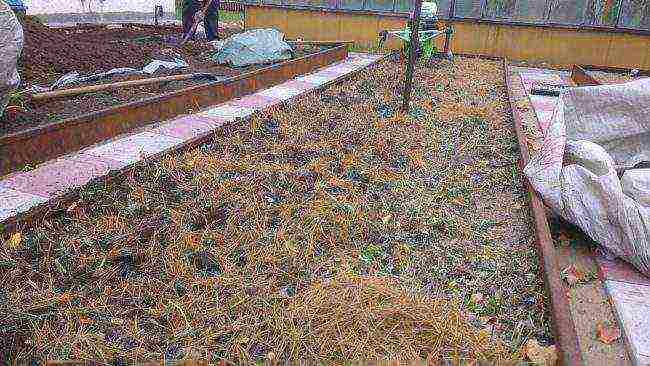
Galina Kizima suggests filling the beds after strawberries with any available plant material and leaving them for a year for natural composting.
Where to get seedlings
Based on his bitter experience, the gardener does not recommend buying strawberry seedlings from the market, from random sellers, and even from neighbors and acquaintances.
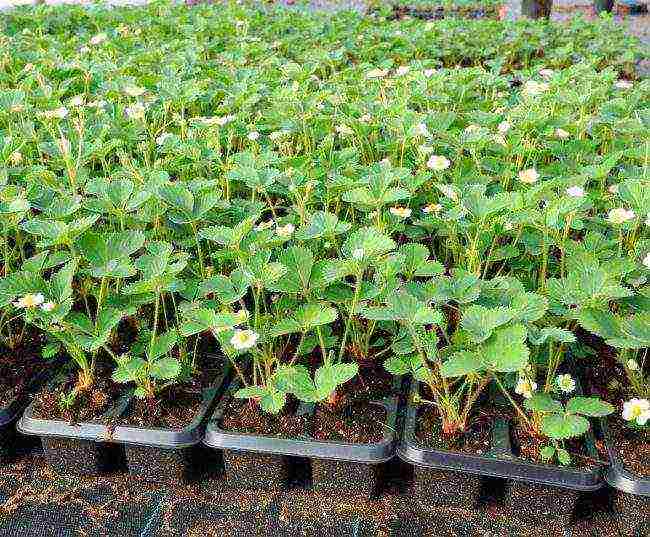
It's hard to disagree with the idea that strawberry seedlings need to be healthy and clean.
The main argument is introduction of pathogens and pests to your plantations. Kizima is confident that nurseries and specialized horticultural centers jealously monitor the cleanliness of the planting material and their reputation, therefore, misgrading and pathogens are less likely.
Kizima is scrupulous about the fact that strawberry varieties must certainly be zoned, and in this she is of course right. In the register of varietal achievements, there are very few varieties recommended for cultivation in all climatic regions, therefore those varieties that are suitable for the southern one cannot be planted in the northern regions.
Kizima draws attention to the fact that clean and zoned planting material - the basis of a productive garden.
What strawberries love
An amateur gardener, observing a fragrant berry, came to the conclusion that strawberries are a phosphate-loving plant. It carries relatively little nutrients from the soil, but is very sensitive to phosphorus deficiency.

AVA fertilizer is a concentrated complex of minerals and trace elements necessary for the successful development of plants.
To provide the bushes with this element, Kizima recommends in each hole when planting apply a pinch (1/3 teaspoon) of AVA fertilizer... If it is impossible to purchase such fertilizer, you can scatter 1 tbsp for each linear meter. spoon of superphosphate and 0.5 teaspoon of potassium sulfate, or other potassium fertilizer, but not containing chlorine.
Kizima also responds positively to the introduction of furnace ash... Her recommended dose is ¼ cups per meter of landings.
What to do with foliage
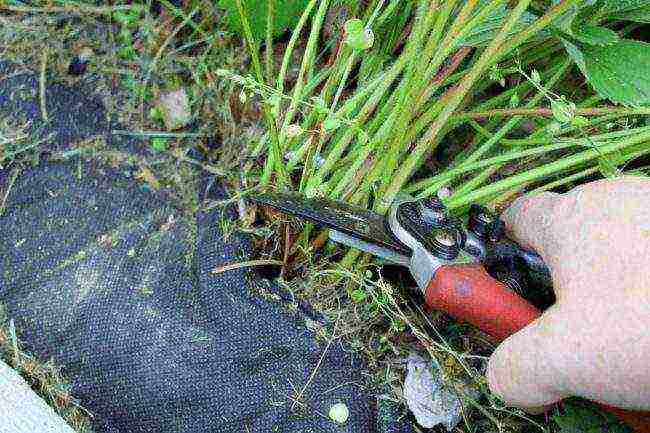
Galina recommends cutting off the foliage immediately after fruiting strawberries.
According to Kizima, strawberry has two growth waves of the leaf apparatus:
- From the beginning of spring until the end of fruiting;
- After the end of fruiting.
The gardener claims that all the foliage of the first wave must be cut off immediately after the end of fruiting. You can start this work even during the berry picking period, then it is better illuminated by the sun.
The leaves of the second wave must be carefully covered from frost and stored until spring.although their role is not explained. But the rhizome takes nutrients from the sockets, according to the author, although, according to her, the root grows earlier than the sockets themselves (then where are the nutrients from?).
Opinion about disease
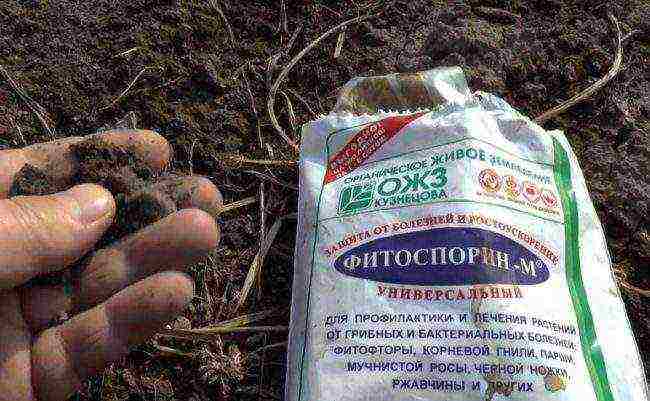
Kizima considers Fitosporin to be the most effective remedy for strawberry diseases.
The most unpleasant strawberry disease that Kizima has encountered is gray rot. At the same time, she recommends making wine from rotten, then trimmed berries (probably, the drink will turn out to be an amateur, the smell alone is worth something).
According to observations, the drug “Fitosporin". The author recommends processing after the snow has melted, then at the time of setting the berries.
Kizima claims that this drug does an excellent job with white and brown leaf spot... For prophylaxis, it is recommended to treat the beds with "Fitosporin" strawberries leaving before winter.
In early spring, the gardener advises to spray the strawberry plantings with a 1% solution of the Bordeaux mixture, and again after harvesting.
The gardener is jealous of withered bushes... If this is an accidental, single wilting, then the strawberry bush must be removed, since it can be a carrier of a viral or mycoplasma infection.
About pests
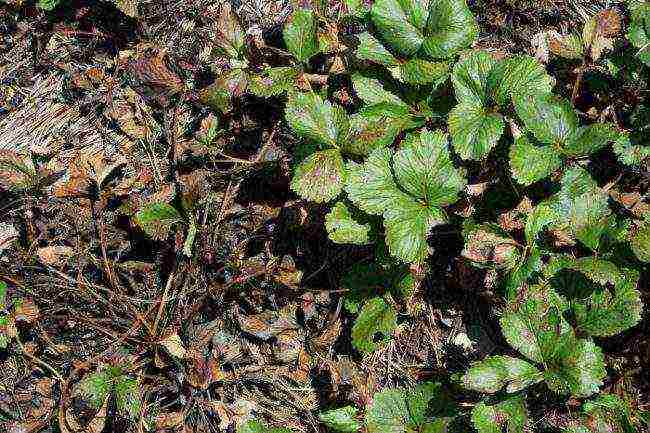
According to Galina, strawberry bushes affected by the nematode need to be destroyed.
The most dangerous pest of strawberries, according to Kizima, is the nematode. Listing the methods of struggle that she had to use, the gardener came to the conclusion that it is most effective to remove the landing completely.
Re-planting strawberries on this plot is possible only after 4–5 years, and only with fresh, clean material.
Mite

There is an opinion that marigolds scare away ticks.
Kizima recommends fighting mites on strawberries with Fitoverm, as the safest for warm-blooded animals, and planting marigolds, which, in her opinion, save from nematodes. The author recommends planting marigolds in any bed of strawberries in the center and around the perimeter.
conclusions
Every experienced gardener has his own opinion about planting, growing, feeding, and sharing it with like-minded people you can always find true knowledge.
Video about the principles of growing crops according to the method of Galina Kizima
Many gardeners have heard of Galina Kizima's method, which can significantly save labor costs when working on the site. "Garden without hassle" - this is the slogan of an experienced gardener. What are the main postulates of this technique?
Galina Kizima's method
The methodology of Galina Kizima was based on the rules of organic gardening, to which she gradually came over 52 years of her "summer cottage" experience. Like many of us, she devoted all her weekends and vacations to working in the garden, hard work in the beds did not allow rest at all. Galina Kizima began to look for ways to reduce labor-intensive manipulations without harming yields.
The principles of agricultural technology and gardening that she worked out sometimes completely contradict the conservative and familiar methods of farming. According to Kizima, most of the manipulations are completely unnecessary and even harm the condition of the soil. By giving up digging, organizing a system for retaining moisture and thereby reducing the frequency and volume of watering, you will be able to relax more in the country, devote the freed up time to your family or garden experiments.
Technique for growing seedlings in diapers
Galina Kizima also developed a technique for growing seedlings, which significantly saves space on the windowsills. The author's technology is based on the so-called. "Diapers", popularly called "Moscow rolls". The method was developed for growing tomato seedlings, but in the case of preparing sprouts of peppers, cabbage, cucumbers and flowers, it also shows good results.
Galina Kizima, in her work "A Vegetable Garden without Trouble", recommends growing seedlings of tomatoes and other crops in non-woven rolls with a small amount of nutritious soil. This technique does not require the traditional filling of containers with soil, which means it saves you money and space on illuminated windowsills.
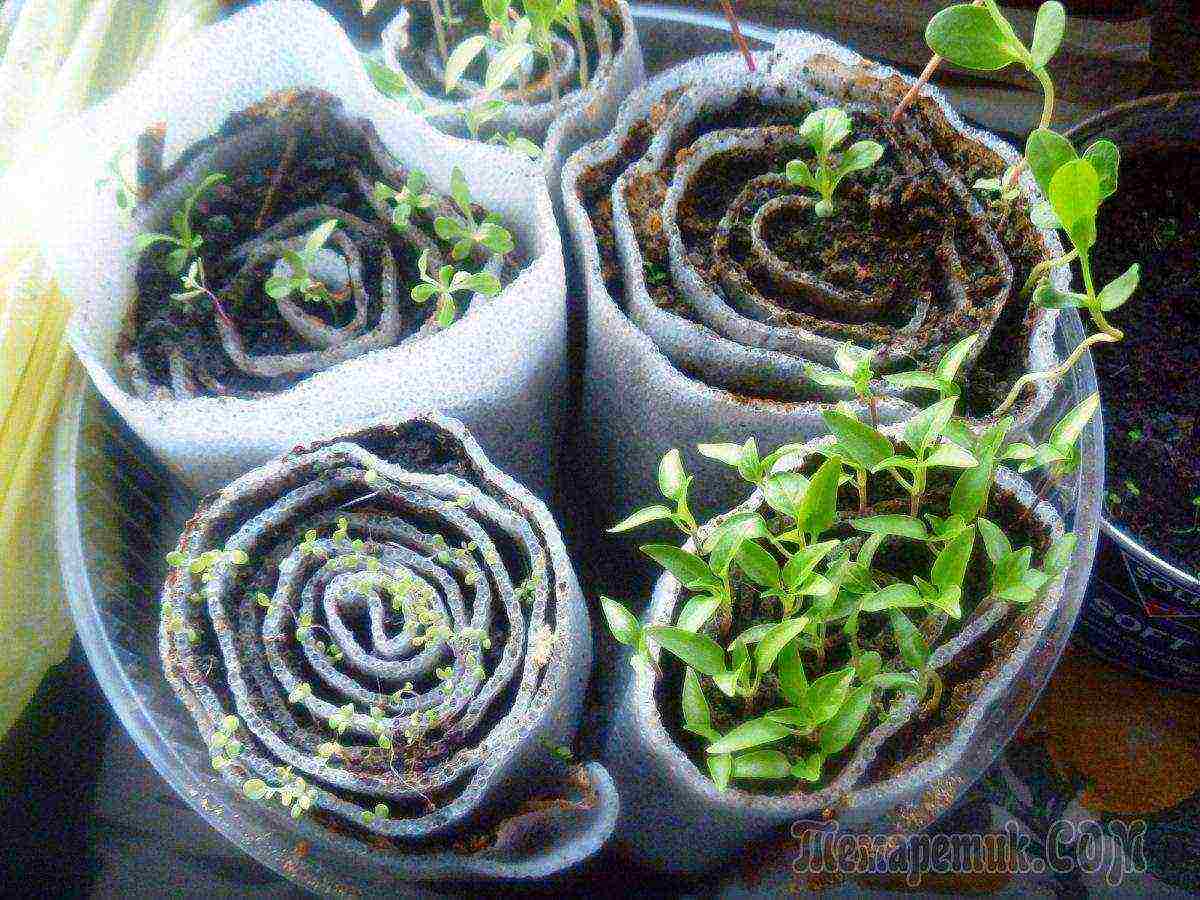
For “swaddling”, soil, seeds and non-woven material (geotextile, dense film or disposable baby diapers) are prepared, which is cut to size. Wet soil is distributed on the diaper in a thin layer, seeds are placed in the upper third of the length, after which it is rolled up and placed vertically in a container.
In addition to saving space, combined with high productivity, the Kizima method of growing seedlings has a number of undeniable advantages: the picking process is much easier, and you can visually assess the quality of the sprouts.
But there are plenty of disadvantages to this method. Sprouts develop worse in confined conditions, the root system is much weaker than the stems. In addition, when picking, you still have to plant the plants in separate pots, so the thesis about saving space becomes controversial. It is advisable to use this technique for growing seedlings of cold-resistant crops, which can be dived directly into the beds or greenhouse.
For thermophilic crops, Galina Kizima proposes to extend the "diaper period" by diving the sprouts into individual rolls with earth, rolled like shawarma. In a relatively spacious bag made of non-woven material, the seedlings will be comfortable, humid and warm, and the plants will be able to sufficiently develop their root system and aboveground part by the time they are planted in the ground or greenhouse.
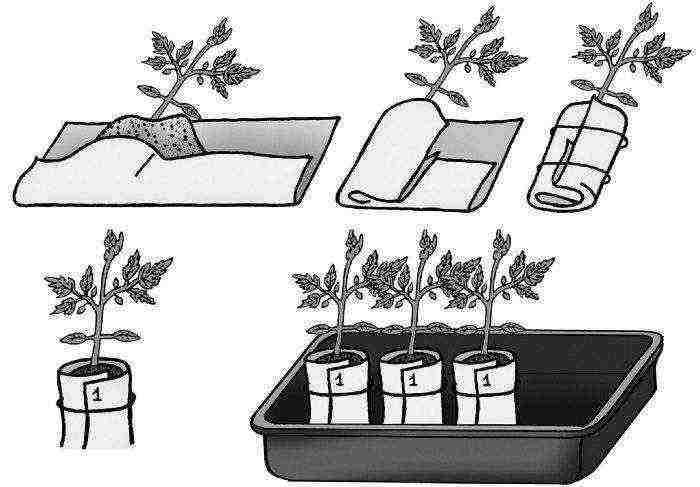
The main principles of the technique
Galina Kizima based her technique on naturalness. In natural conditions - in a forest or in a field - there is no area on the ground that is not occupied by plants. They coexist perfectly together, do not require fertilization, additional watering and digging up the earth, and at the same time they develop well and give a crop.
On garden plots, the opposite picture is observed: the more a person works and puts in effort, the worse the result. Galina Kizima turned to organic principles of cultivation and developed her own methodology, which is based on the desire to abandon unnecessary and harmful work in the garden.
Digging
The first postulate of the technique is not to dig. The autumn and spring digging of the garden is very harmful to the soil, so Galina Kizima calls on gardeners to abandon shovels and pitchforks. There are several good reasons for this:
- High-quality soil has its own structure: aerobic microorganisms live in it at a depth of 20 cm, anaerobic microorganisms from 20 to 40 cm. These bacteria, in the course of their vital activity, make the earth fertile, due to the active fermentation of organic matter and the breakdown of mineral elements. During a standard digging "with a bayonet" these living layers change places, and microorganisms die in unfavorable conditions for them.
- In the field and in the forest, the land is always a little springy, it is soft and lush, in the garden, after watering and rains, we are forced to loosen the beds in order to knock down a specific crust. Under natural conditions, the soil contains microchannels formed by a wide network of dead plant roots processed by bacteria, with their help the soil breathes and is quickly saturated with rainwater. When we dig up a vegetable garden, we destroy these passages, and the dense earth does not allow the roots of cultivated crops to breathe and eat.
- During autumn and spring digging, we constantly select the roots of weeds, but weeds still grow before cultivated crops. This happens due to the fact that we ourselves deepen their seeds before winter, and before planting work we turn them over again closer to the surface.
Digging dries up and kills the soil. Even the black soil brought to the site, after a few years, loses its fertility and turns into a kind of sand, losing important bacteria. To save your land, you cannot dig it. To prepare the beds shallowly - up to 5 cm - loosen the soil with any tool convenient for you - a hoe, rake or pitchfork.
Weeding
After the end of sowing work in the garden there is no time to relax - weed sprouts already appear in the beds, which must be fought mercilessly all summer so that they do not take food from the planted crops. Galina Kizima has found an effective and low-effort way of dealing with them.It is not necessary to weed the weeds - they need to be cut off at the root in time or with a slight deepening of 2-3 cm using special tools.
It is necessary to cut the weeds when they reach a height of 5-10 cm. The constant removal of the green part will lead to the suppression of the root system, which is difficult to do without chlorophyll, which is important for it. Cut weeds are left directly in the garden to serve as natural mulch and organic fertilizer.
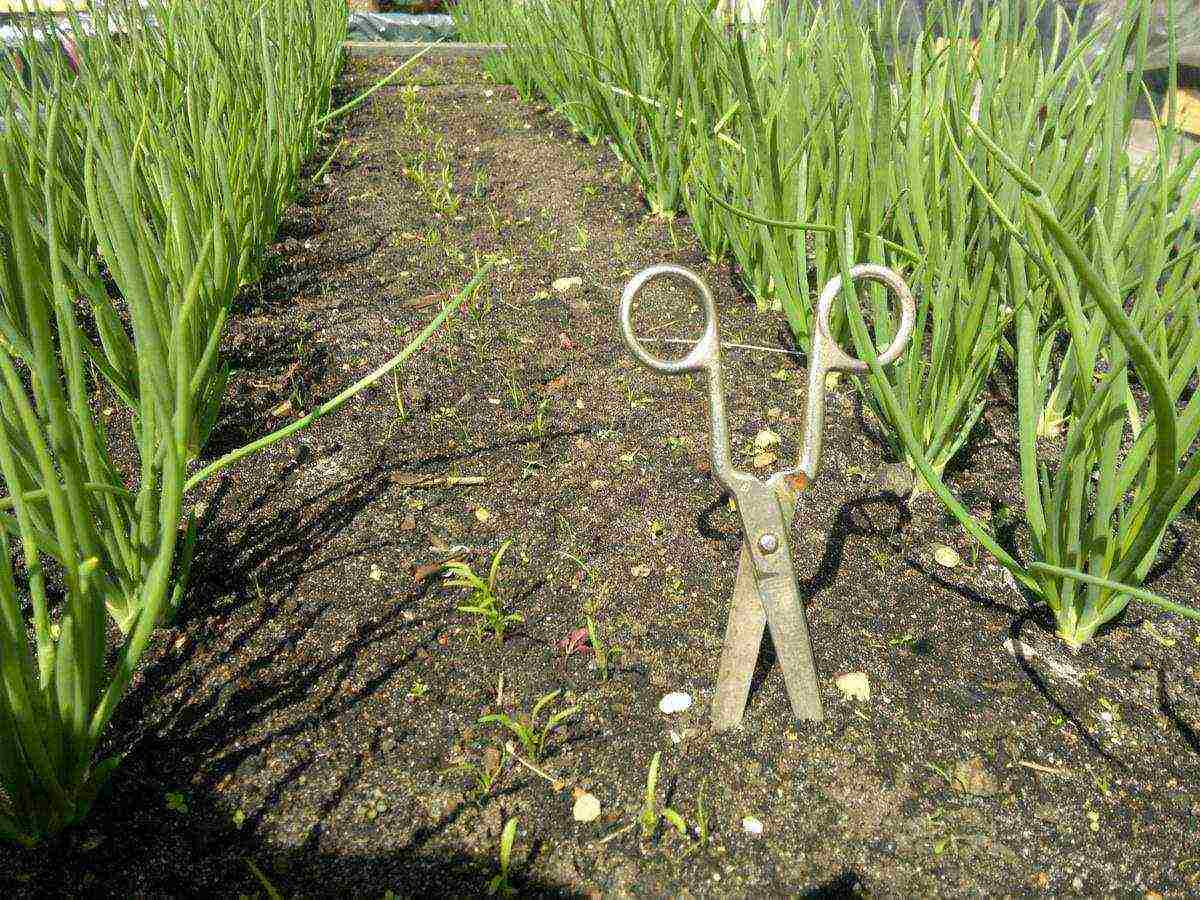
During the season, you will need to make only 3-4 cuts, this will be quite enough for the weeds to die. These manipulations are less labor intensive than traditional weeding, and the efficiency is much higher. The green part of the weeds serves as mulch, protecting the soil from drying out, and also acts as a permanent compost fertilizer. Dead roots will serve as food for bacteria, which will increase soil fertility.
Growing weeds
Another method of Kizima gardening, which helps to cope with weeds, is based on the early germination of the seeds of "unwanted" plants present in the soil:
- In early spring, beds with lying snow are accentuated with peat or ash and covered with foil.
- The blackened snow under the film will melt quickly, and the soil will warm up to temperatures sufficient for the germination of weed seeds.
- After 2 weeks, seedlings will appear under the film, which must be knocked down by loosening and leaving the beds open for a day.
- Cover the beds with foil again for 2 weeks. Weed shoots from deeper seeds will appear on them.
Repeat loosening and in a day you can sow cultivated plants. The main thing is not to dig up the soil before planting, so as not to carry the seeds of weeds into the upper layers.
Watering
Watering is a daily and grueling ritual that gardeners spend up to an hour of free time every evening. Of course, automatic systems and all kinds of sprinklers greatly simplify the work, but isn't it easier to organize everything in such a way as to prevent moisture from evaporating? In this case, the frequency of watering and the volume of water can be significantly reduced.
The most effective way to retain moisture in the soil is by mulching. A thick layer of air will cover the ground and prevent it from drying out, and also prevent the introduction of weed seeds into the beds. As mulch, you can use:
- sawdust and straw;
- coniferous needles or high moor peat (acidify the soil, so you need to regularly add ash or lime);
- black non-woven fabric;
- cardboard;
- newspapers;
- office paper;
- fallen leaves;
- cut grass.
By mulching the seedbeds, you will significantly reduce your labor costs to provide crops with moisture. You will have to water, but less often, while you need to take into account the characteristics of plants and their ability to collect and consume water. Most of all, cabbage, cucumbers, radishes, lettuce, beets and rutabagas need watering, but peppers, tomatoes, pumpkins, zucchini and carrots are perfectly able to get food on their own and use it sparingly. With the initially correct organization of planting, this group can be approached with a watering can only during dry periods.
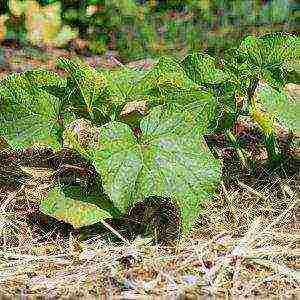
How to simplify the care of strawberries ("strawberries")?
It is believed that in the garden, perhaps the most laborious work is caring for the plantings of strawberries. This is a big misconception! She came to us from the forest and can grow with almost no care. No, of course you won't be able to do anything at all, but the work can be minimized.
So, grow it the carpet way. For the first time I read about him in the magazine "Household Economy" about 20-25 years ago. I took advantage of this information. But the gardening neighbors began to accuse me of turning the site into a breeding ground for pests and diseases. Under their onslaught, I switched to slave labor to grow this very strawberry. But as I got older, I began to think more and, accordingly, work less on my own six hundred square meters.And it turned out that the cost of mental and physical labor is a constant value. Either you work harder and think less, or vice versa, and the result of your activity is about the same. Having experimented this way and that, I came to the conclusion that the most reasonable way to grow garden strawberries is carpet.
What it is? You give the strawberries some space and leave them to their fate. She, of course, will be delighted and will begin to capture the entire surrounding space, giving a large number of whiskers at first. But then it will "catch up", because the living space is limited, and will sharply reduce vegetative reproduction, giving a very limited number of whiskers.
I do not cut out the fruit-bearing flower stalks, despite the fact that textbooks frighten them with rotting at the root, I do not cut off the mustache and outdated leaves, contrary to popular belief. And nothing, grows and bears fruit like a pretty one, and does not bend at all from pests and diseases (on which I have a very simple bridle). My task is to plant it correctly (from my point of view) and harvest it. Well, please tell me, who works it in the forest without straightening his back? Nobody. So why did we come up with such hard labor on our heads? Let us, gentlemen-gardeners, get rid of it, and immediately on the site “life will become better, life will become more fun”! But everything is in order.
Next chapter>
Many city dwellers only get to their garden plots on weekends. In those one and a half days, there is little that can be done. In this regard, the question arises of how to organize work on the site so that the harvest is pleasing, and not be exhausted at the same time. The principle of a garden-garden without the hassle of Kizima Galina gives such a chance. Based on her observations, she found an opportunity to do this and explained how to reduce the most time-consuming components of garden work.
Methods to reduce the labor intensity of gardening
Any owner of summer cottages knows how hard it is to dig the ground, and if there is no central water supply, also water the entire planting season. Not to mention the daily weeding of the beds.

The amateur gardener Kizima has been involved in plant growing for several decades. She empirically created a garden of dreams. Galina Kizima's no-worries gardening method is now widely used all over the world. She found out that in order to organize a miracle garden, there is no need to dig the ground, weed the beds and water the plantings.
Excluding digging
The hardest part of gardening is digging up the beds. By method Galina Aleksandrovna, the need for this completely disappears... There are five reasons for this:
Same
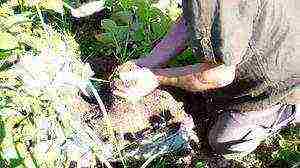 When digging to the depth of the bayonet of the shovel, the soil layer turns over, which means that microorganisms change places, which by their nature can exist at a certain depth. Some need oxygen for life, others need carbon dioxide. When the formation is turned over, both of them die. The soil is deprived of natural microorganisms and loses fertility, its structure is destroyed.
When digging to the depth of the bayonet of the shovel, the soil layer turns over, which means that microorganisms change places, which by their nature can exist at a certain depth. Some need oxygen for life, others need carbon dioxide. When the formation is turned over, both of them die. The soil is deprived of natural microorganisms and loses fertility, its structure is destroyed.- When digging, natural microchannels are disturbed through which moisture and air circulate, thereby deteriorating plant nutrition. The soil devoid of structure cakes, dries up and makes it even more difficult to deliver the necessary elements to the roots of plants. Microchannels are formed after the ingestion of dead roots by underground microorganisms. They are densely branched and evenly distributed throughout the entire depth of the soil. When the formation is turned over, all this is disturbed and it takes a long time to recover. Plants suffer.
- During autumn digging, weed seeds are transferred from the surface to the depths, where they winter wonderfully. During the spring overturning of the layer, they are carried to the surface and germinate together.
- After digging, the soil, left without a grass shelter, dries quickly in the sun. Moisture is lost. Weeds begin to grow quickly on unprotected land.
- The soil should not be deprived of its natural shelter in the form of dry leaves and grass. These organics are designed to protect and nourish the earth.
The fertile layer - the humus covering the soil, is sprayed throughout the entire thickness of the layer when digging, thereby depriving the planting of food. Of course, it will rise later, but plants need it right now.
To get around all these "no", you just need to loosen the ground. To do this, you can use a Fokin flat cutter, a rake, a sharpened hoe or a weeder. Only the tool should always be well sharpened. The loosening height is no more than 5 centimeters. A hand-held cultivator simultaneously loosens the soil and cuts weeds.
Growing a vegetable garden without weeding
You just need to cut the weeds under the root. It is important not to let them outgrow, otherwise they will displace cultivated plants. The permissible weed height is 5-15 centimeters. They should be shaved using familiar tools. The cut grass remains in place as additional mulch. This is the result:
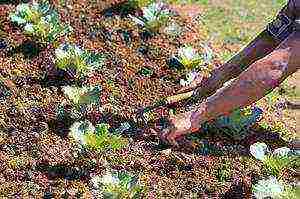 Weed roots die without photosynthesis of cut stems. If something has sprouted from the root buds, it is shaved off in the same way over time. For 3-4 cuts during the summer, you can forever say goodbye to weeds.
Weed roots die without photosynthesis of cut stems. If something has sprouted from the root buds, it is shaved off in the same way over time. For 3-4 cuts during the summer, you can forever say goodbye to weeds.- The cut grass mulches the beds.
- Decaying, cut grass serves as additional food for plantings.
- There is no need to carry the cut grass into the compost pit.
- Naturally rotted compost covers all our plants in an even layer. It does not need to be carried in buckets from the compost pit and distributed over the site.
- Weed roots that remain underground rot and serve as a source of nutrition for the roots of cultivated plants.
Reducing watering
You can do without this hard work. You just need to keep the moisture in the soil. To do this, it should be protected from evaporation by mulching, that is, by covering the soil surface. Both organic and inorganic material can be used as mulch. It can be sawdust, pine needles, peat, dry herbs, dark-colored covering materials, paper.
Watering can be adjusted depending on the crop and weather conditions. For example, not all garden crops consume water equally. They are classified into four groups:
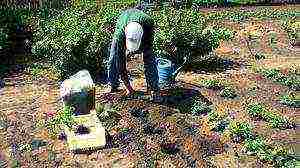 Vegetables that do not know how to draw water, but spend a lot. These are cabbage, cucumber, lettuce, radish.
Vegetables that do not know how to draw water, but spend a lot. These are cabbage, cucumber, lettuce, radish.- Plants that produce poorly water, but consume little of it. These are onions and garlic.
- Beets and rutabagas extract enough water, but they consume it too much.
- Pepper, tomatoes, carrots, parsley, zucchini, pumpkin, melon, watermelon - great! They draw water well and consume economically.
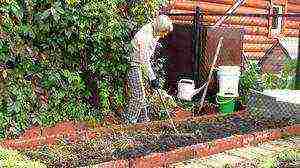 Based on this information, you can determine the amount of water required for irrigation. The fourth group may not be watered at all, if some techniques are applied during planting. To do this, you need to add a sufficient amount of supporting fertilizers to the hole, pour at least five liters of water, plant seedlings, spud and mulch very well. And that's all, you can no longer water. Exceptions are prolonged cold weather or very hot and dry weather. In this case, abundant watering is carried out with the addition of top dressing once every three weeks.
Based on this information, you can determine the amount of water required for irrigation. The fourth group may not be watered at all, if some techniques are applied during planting. To do this, you need to add a sufficient amount of supporting fertilizers to the hole, pour at least five liters of water, plant seedlings, spud and mulch very well. And that's all, you can no longer water. Exceptions are prolonged cold weather or very hot and dry weather. In this case, abundant watering is carried out with the addition of top dressing once every three weeks.
The first three groups of vegetables can be severely limited in water use. The main thing is to mulch very well!
Features of growing potatoes
Kizima pays much attention to the second food product after bread - potatoes. This is how the gardener Kizima talks about a garden without hassle for potatoes:
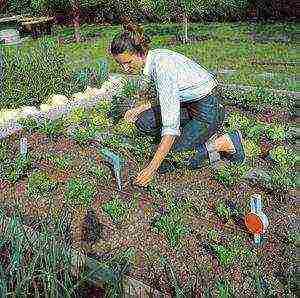 First, you need to prepare the tubers, that is, wash, pour hot water (+45 ° C) until they cool, add a solution of potassium permanganate to disinfect the planting material. After 15 minutes, remove the tubers, wash and wipe.
First, you need to prepare the tubers, that is, wash, pour hot water (+45 ° C) until they cool, add a solution of potassium permanganate to disinfect the planting material. After 15 minutes, remove the tubers, wash and wipe.- Expose tubers to light for greening for 2-3 weeks. As a result, corned beef poison will accumulate under the skin of the potato, which repels pests.
- Then remove the tubers in a dark and warm place for germination. It will take another half month.
The preparatory process should be completed before the cherry blossoms or a little earlier. On the advice of Galina Kizima, potatoes should be planted during this period:
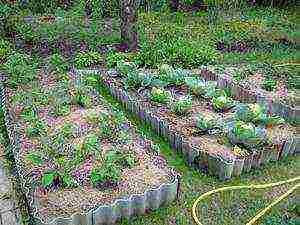 Choose a seat for landing. In no case should the virgin soil be dug.
Choose a seat for landing. In no case should the virgin soil be dug.- Spread the sprouted tubers directly on the untouched ground. Row spacings are recommended to be 40-50 cm wide, and leave a distance of 25 cm between the potatoes. Also, 20-25 cm should be left from each row to the edge of the garden.
- The optimal size of the planting material is 50-60 grams (chicken egg).
- It is advisable to plant different varieties in different beds. The ripening period for them may be different.
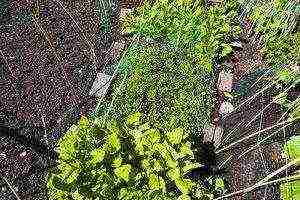 For planting potatoes, you need to choose a sunny place, otherwise you can get a crop of tops, and not potatoes.
For planting potatoes, you need to choose a sunny place, otherwise you can get a crop of tops, and not potatoes.
At the time of spring frosts, the rows of plantings should be covered with dry hygroscopic material. Meadow hay, dry leaves or the top dry compost layer work well for this. From above, everything is covered and strengthened with non-woven fabric or old bags. When warm days come, the upper canvas must be removed and gradually put on the beds everything that has been mowed or weeded out by this time. In short, you need to fill up the plantings with what is usually used for compost. It is these materials that should be earthed up. You just need to make sure that the tubers are not exposed. The result is:
- Fertilizers are not needed for planting. Bushes get them from compost.
- There is no need to water the beds. They get enough moisture from the same waste.
- Perennial weeds under planting will die over the summer without receiving sunlight.
To increase the yield of potatoes, it is recommended to cut off the tops of the tops with flowers. So the plant will be able to give mass to tubers, and not tops. You only need to leave a few flowers to know when the potatoes are ripe. As soon as the flowers begin to wilt, the first crop can be taken. To do this, you just need to move the compost layer and get the right amount of tubers. The rest continue to grow and mature.
After harvesting, the tops should also be laid out in the sun to destroy the corned beef, and then used as compost. After harvesting, the compost heap is left in place until spring and is used as rotted compost.
Subtleties of cultivation of strawberries
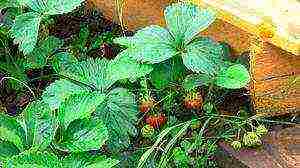 The method of Kizima Galina Aleksandrovna "A garden without hassle" is also applicable to garden berries, for example, to strawberries. Galina is sure that strawberries in the garden should grow as freely as in nature. Thus, there is no need to weed, fight with a mustache, clean the plantings from dried leaves and stems. The only thing that strawberries need is frequent and abundant watering and fertilization in the ground before planting with preparations such as AVA-10 and azofosk.
The method of Kizima Galina Aleksandrovna "A garden without hassle" is also applicable to garden berries, for example, to strawberries. Galina is sure that strawberries in the garden should grow as freely as in nature. Thus, there is no need to weed, fight with a mustache, clean the plantings from dried leaves and stems. The only thing that strawberries need is frequent and abundant watering and fertilization in the ground before planting with preparations such as AVA-10 and azofosk.
Since the berry forms a mustache throughout the growing season and strives to conquer more and more territory, the beds must be limited by digging around the perimeter or boards. After 3-4 years, the fruiting of the plantation begins to decrease. There is a need to dispose of old plantings and prepare a site for a new berry plant. Kizima suggests doing the following:
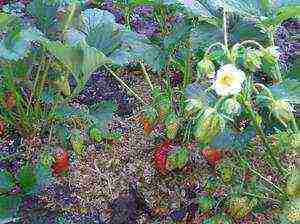 In late autumn, fill up the berry field with dried grass, fallen leaves, straw and other agricultural waste. In a word, organize composting. To speed up the processing of biomaterials, spill a bunch of drugs like Baikal or Renaissance and cover with a dark plastic wrap until next spring.
In late autumn, fill up the berry field with dried grass, fallen leaves, straw and other agricultural waste. In a word, organize composting. To speed up the processing of biomaterials, spill a bunch of drugs like Baikal or Renaissance and cover with a dark plastic wrap until next spring.- At the beginning of the season, the cover is removed. Several times during the summer, the entire site is generously fed with biologics Fitosporin and Gumi.
- It is expected that the site for the new berry plantation will be ready by August.
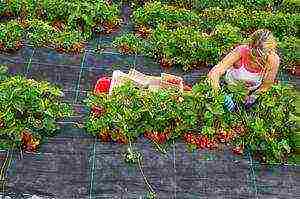 To avoid the introduction of harmful bacteria and pests, it is recommended to purchase planting material only in nurseries or specialized centers. It will be optimal to plant only zoned varieties. There are not so many universal ones and they do not differ in special productivity.
To avoid the introduction of harmful bacteria and pests, it is recommended to purchase planting material only in nurseries or specialized centers. It will be optimal to plant only zoned varieties. There are not so many universal ones and they do not differ in special productivity.
Long-term observations of garden berries have shown that strawberries are responsive to phosphorus fertilizers. There is also a balanced fertilizer for her - this is AVA. It is advisable to make it during landing. One pinch per bush is enough. As a substitute, you can use superphosphate in combination with potassium sulfate. It is enough to add one tablespoon of the mixture to one running meter. If these fertilizers are not at hand, you can get by with ash. Its dosage is a quarter of a glass per meter of planting.
The most severe disease of the berry is gray rot. Fitosporin will help to destroy it. The same drug is useful in combating white and brown spotting of strawberry leaves. It is advisable to carry out the processing twice: in very early spring and during the setting of the berries. For prevention, it does not hurt to repeat it before winter. Additionally, it is recommended to treat the berry beds with Bordeaux liquid before and after the fruiting season.
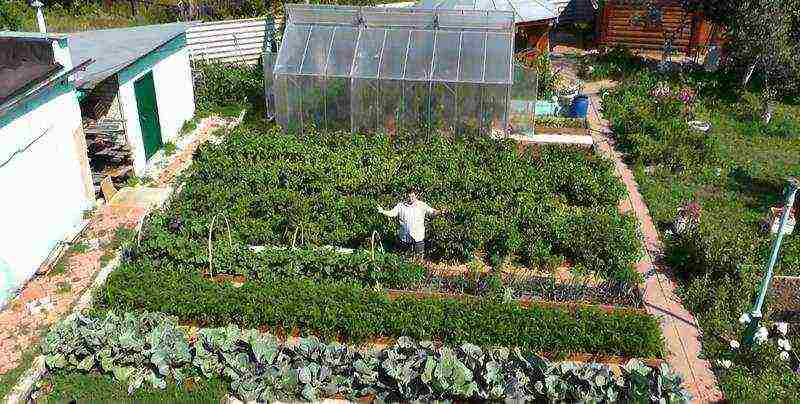
According to Galina Kizima, the most serious enemies of strawberries are nematodes and ticks. In the case of the nematode, Kizima advises to dig up the bushes completely and eliminate. Re-planting in this area is recommended only after 4-5 years using certified planting material. You can protect the berry from the tick with Fitoverm or the frequent planting of marigolds. They are desirable to plant the beds around the perimeter and start a line in the center.
The Kizima method opens up completely new possibilities in gardening and horticulture. Following the advice of the gardener, summer cottage work can be turned into a favorite hobby and you can easily achieve good harvests.

